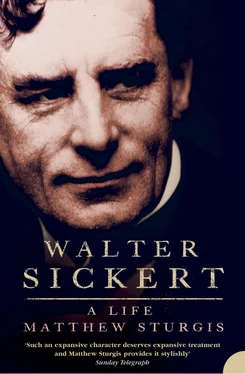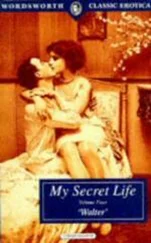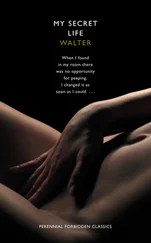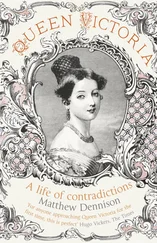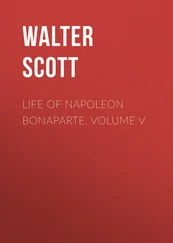Once Sickert began work on this new theme, he quickly came to realize that the methods and techniques he had learnt from Whistler provided almost no clue of how to proceed. A pochade box was useless: sitting in the semi-darkness of a music hall unable to see his colours or move his elbows, he could not paint from life. Painting the whole scene from memory – as Whistler did with his nocturnes – was likewise impossible. He could study and observe – but only so much. Compared to a Thames-side warehouse, the auditorium of a London music hall was both too complex and too fugitive to be learnt in full. So he turned instead to the example of Degas. He started to work from snatches of repeatedly ‘observed and remembered’ movement, from drawings, and from notes. 5 He returned night after night to the same seat in the same music hall to study his scene: to memorize and set down a single significant move or gesture, to note the divisions of light and shade, the subtle grades of tone, and the rich vestiges of colour. It was as a detached, unobserved member of an excited audience that Sickert evolved his rare power of objective vision – ‘the one thing’, as he later described it, ‘in all my experience that I cling to … my coolness and leisurely exhilarated contemplation’. 6 He proliferated tiny drawings, some done in little, lined, laundry books, others on postcards. 7 He captioned them with colour notes, or – more often – with the words of a song or a snatch of dialogue: an aural aidemémoire. The composition of the pictures was mapped out, the elements marshalled, and the paint applied, not on site but back in the studio. In most of his early experiments he borrowed from Degas the conventions of Mlle Bécat aux Ambassadeurs – viewing a single footlit artiste over a ragged silhouette of foreground figures.
At the 1887 spring exhibition of the SBA, Sickert unveiled his first music-hall painting – Le Mammoth Comique . The picture – a small canvas of an open-mouthed, evening-suited singer standing against a stage backdrop with the orchestra pit in the foreground – provoked surprisingly little comment. It was admired as being ‘clever’ by both the critic from the Daily Telegraph and by Mrs Sickert; 8 but the debt to Degas was not remarked. Whistler’s views on the work are unknown. 9 The President had other things to engage his attention that season. The Prince and Princess of Wales visited the exhibition. * There were hopes that the society would be given a Royal Charter and even that the President might receive a knighthood. (The former came to pass, the latter did not.) Another visitor was Claude Monet, who had come over to stay with Whistler and promised to send work to the next exhibition. Amongst these excitements, Sickert’s little music-hall scene was a minor distraction.
At the beginning of June, Sickert – together with Ellen – crossed to the Netherlands to stay at the seaside resort of Scheveningen. 10 The excursion may have been, in part, an act of piety, for Whistler had painted and etched there often. Sickert, too, made numerous small etchings of the beach and its distinctive hooded wicker chairs – or windstolen – as well as some rather brighter and less obviously Whistlerian paintings. Yet even when working in his master’s idiom, Sickert’s own voice was becoming gradually more apparent. The etchings that he showed that November at the Society of Painter-Etchers – where, greatly to Ellen’s delight, he had been elected a fellow – were praised for their ‘individuality’ and accomplishment. 11
‘Individuality’ was not something that Whistler particularly encouraged amongst his pupils. He seems to have ignored Sickert’s achievements, and engaged him instead in his own printmaking activities. Under the guidance of his printer friend Thomas Way, Whistler was experimenting with lithography after a break of several years, 12 and Sickert was invited to try his hand at the medium. 13 Rather less flatteringly, he was also charged with carrying the Master’s weighty lithographic stone when they set out together of an evening, ‘in case inspiration should come during or after dinner’. As a friend recorded, ‘at the Café Royal or elsewhere the waiter was enjoined to place an extra table for the stone’, but more often than not it was still untouched when Sickert would have to carry it away at the end of the night’s entertainment. 14
Sickert did not seek to build on the achievement of Le Mammoth Comique at the winter exhibition of the now ‘Royal’ Society of British Artists. 15 He was keeping his powder dry, for all was not well at Suffolk Street. Although Whistler’s achievement of royal patronage had won the universal approbation of the SBA membership, on most other fronts he was assailed by complaints. Seeking to bring matters to a head, he put forward a motion calling for members to resign their attachments to all other societies, including even the Royal Academy. This was not a popular move. Many members exhibited and sold pictures with other variously distinguished national and local societies. They saw nothing to gain from complete exclusivity and much to lose. Rather than provoking the conservative element to leave the club, as he had hoped, Whistler provoked them into rebellion. His motion was defeated, and a battle line was drawn. A group of members began to campaign for the President’s removal; and although Whistler sought to bolster his position by drafting more supporters into the ranks of the society (Théodore Roussel and Waldo Story both became members in 1887), the vulnerability of his position became increasingly apparent.
It was against this gathering crisis that Sickert began to look beyond the confines of Suffolk Street. The RSBA was, he realized, ‘a house divided against itself’ and ‘the split’ would come ‘sooner or later’. 16 It was as well to be prepared. As a non-member he relied on the Whistlerian control of the selection process to secure a showing for his pictures. If Whistler were ousted there could be no guarantee that his work would continue to be accepted, and every possibility that it would not.
Sickert needed to find a new forum for his work. Steer and several other of Sickert’s Baker Street confrères had recently exhibited with a society called the New English Art Club, and their example encouraged him to look in this direction. 17 The club had been established only the previous year, in 1886, by a group of artists, the majority of whom had received some training in the Paris studios (indeed one suggested name for the club had been ‘The Society of Anglo-French Painters’). 18 The original members were ‘a mixed crew’ and the influence that France exerted over the work took various forms – and existed at various strengths. 19 John Singer Sargent was a founder member, but perhaps the dominant artistic strain was the large-scale plein-airism derived from Bastien-Lepage: scenes of a slightly sentimentalized English rural realism done in ‘what [was] known as French technique’. 20 This school was represented by George Clausen, Stanhope Forbes, Henry la Thangue, Henry Scott Tuke, and numerous lesser lights.
Besides the Baker Street group, there were a few other members of the new body who professed an interest in the work of the French Impressionists, even if their own pictures tended to show only the faintest traces of actual influence. It was one of these, Fred Brown, who had invited Steer to exhibit with the club, having been impressed by the quasi-idyllic painting of a goat girl exhibited at the SBA in 1885. 21 Brown, then in his mid thirties, had been teaching at the Westminster School of Art since 1877, offering night classes in drawing and painting to working men and part-time students. He was an inspired and inspiring teacher, and had established a reputation for the clarity of his approach. It was work that kept him in touch with the rising generation of artists – as well as giving him a taste for administrative organization. He emerged as one of the guiding spirits of the new club and drew up its novel, and thoroughly democratic, constitution: there was no president, only an honorary secretary; and exhibitors had the same voting rights as members. 22
Читать дальше
